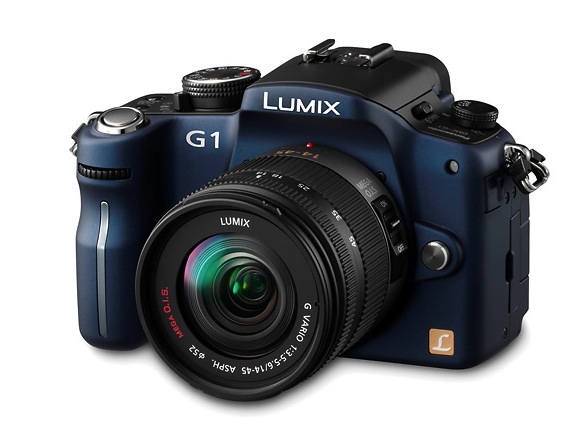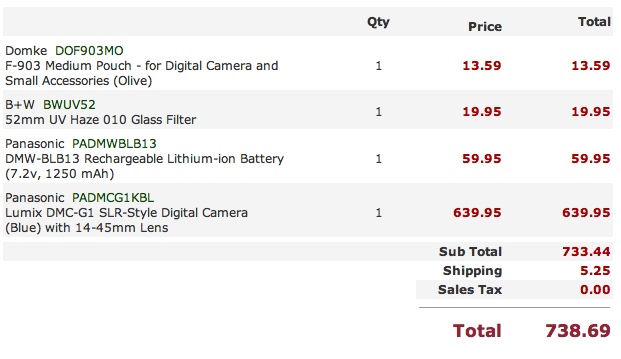To read the whole series on the Panasonic G1, click here
In a moment of insanity occasioned by despair at anyone ever introducing a small camera with a large digital sensor and with low shutter and autofocus lag, I asked a fellow photographer whether the only choice was a Leica M8, a camera I have remorselessly trashed in these pages for its dated, inept technology, ridiculous price and poor execution. And it’s not like I’m some sort of Leica-hating nut, having used M2, M3 and M6 film cameras for 35 years.
The reply gave me a well deserved spanking. I mean what was I thinking of buying that piece of antique jewelry?
“Come on, Thomas. I know that engineers love shiny, well-machined metal, but an M8? I think it was The Master who called it “nothing more than a joke”. There was a TV show a while back in which a photographer might or might not have been the father of a young woman. He gave her an M8, and in trying to solve the mystery, I wondered whether he was her father because he gave her such an expensive gift, or whether he wasn’t her father and just wanted to get rid of it.
There are so many really interesting cameras around that are worthy of your attention. The LX3 is a real improvement on your LX1. There are the 4/3rds cameras, which might be useful with the pancake lenses. I just bought the new Panasonic ZS3 (TZ7 in Europe) which will fit into your 501s better than the LX1, despite its awesome 25mm-300mm lens. I was trying it out today, and you can see the results below. I was quite far away from the subjects when I took the shots.”
Well, anyway, getting an M8 would have involved an extended diet of crow, not to mention an extended diet, period, so I dropped the idea. The Digital Pen makes the mistake of not having a proper viewfinder – sorry, but LCD screens do not cut it, nor does an arm-outstretched posture work when snapping pictures, at least not for this photographer – so that idea went the way of the dodo. By the time you add the optical viewfinder you have bulk equal to a small DSLR – and a lousy viewfinder.
I have rethought what I wrote here and have ordered a Panasonic G1 camera. Having scanned the reviews and now that the camera has been on the market for some 9 months, I concluded that it might do the trick – a fast, small and unobtrusive street snapper at modest cost. Even experienced photographers seem more than happy with the electronic viewfinder and the responsiveness. Although the camera is not pocketable, it is reminiscent of my old Pentax ME Super of bygone film days and it’s not like I am going to be heart broken if someone steals it. Try saying that about that dated antique, the Leica M8. If you ever remove it from the display case at home, that is.

The Panasonic G1. In blue. On order now!
Mine will come in blue because that looks really amateur which is important to me. I hate black, there’s no chrome version and the red is over the top – British Racing Green would have been nice. It comes with a somewhat underwhelmingly spec’d 14-45mm f/3.5-5.6 kit lens, but that optic has garnered uniformly fine reviews and the inclusion of an image stabilizer in the lens goes some way to making up for the uninspiring maximum aperture. And the 28-90mm full frame-equivalent zoom range is just what the doctor ordered. Further, the sensor dust cleaner should counter one of the biggest bugaboos of my Canon 5D – sensor dust.
The Electronic Viewfinder (EVF) has enjoyed generally positive comments except in really poor light. Those EVFs I have tried so far are, simply stated, just awful. And while I refuse to hold my camera two feet away from my face, the swiveling LCD screen suggests some intriguing waist level opportunities if the LCD screen is remotely usable in bright light. It should be fine, I’m guessing, in poor light where it takes the place of the EVF.
While you can adapt Leica M lenses to the body, the 2x focal length magnification factor makes most of these less than ideal, and users have commented on the poor performance of the 28mm and wider Leica optics at the edges of the frame, owing to the dated, non-retrofocus optical designs which place the nodal point too close to the sensor and its photosites. At least that’s what they meant! Plus you are back to fear of theft again – have you priced Leica M optics recently? I don’t mind wearing $10k on my wrist but on my shoulder ready to be snatched? I don’t think so.
But the icing on the cake here, if the G1 works out, is the prospect of a 20mm f/1.7 pancake lens (=40mm) which will take me right back to my New York days, if not to New York, and that lovely ME Super with its superb 40mm Pancake Takumar. The 20mm lens has not been released at the time of writing.
Meanwhile, if you want mind-numbing technical analysis of the camera, you need go no further than DP Review, which sets the standard for objective analysis and measurement of modern digital cameras.
By the way, if you wonder why the Leica name is missing from the lens on the G1 (Leica has designed many lenses for recent point-and-shoot Panasonic cameras), just read this piece between the lines to see how Panasonic thinks. They use software to correct aberrations rather than making ever more expensive optics. Surely this is the way of the future?
I’m off to find some blue tape to obscure those awful manufacturer’s markings on the front.
Will this be the ‘digital M2’ I have been waiting for all these years? Time will tell, but it’s not a very costly experiment.

Actually, you can double that, consonant with my strict principle that a dollar blown on a toy dictates that a like amount be sent to my better half. That’s also a compelling reason not to get an M8!